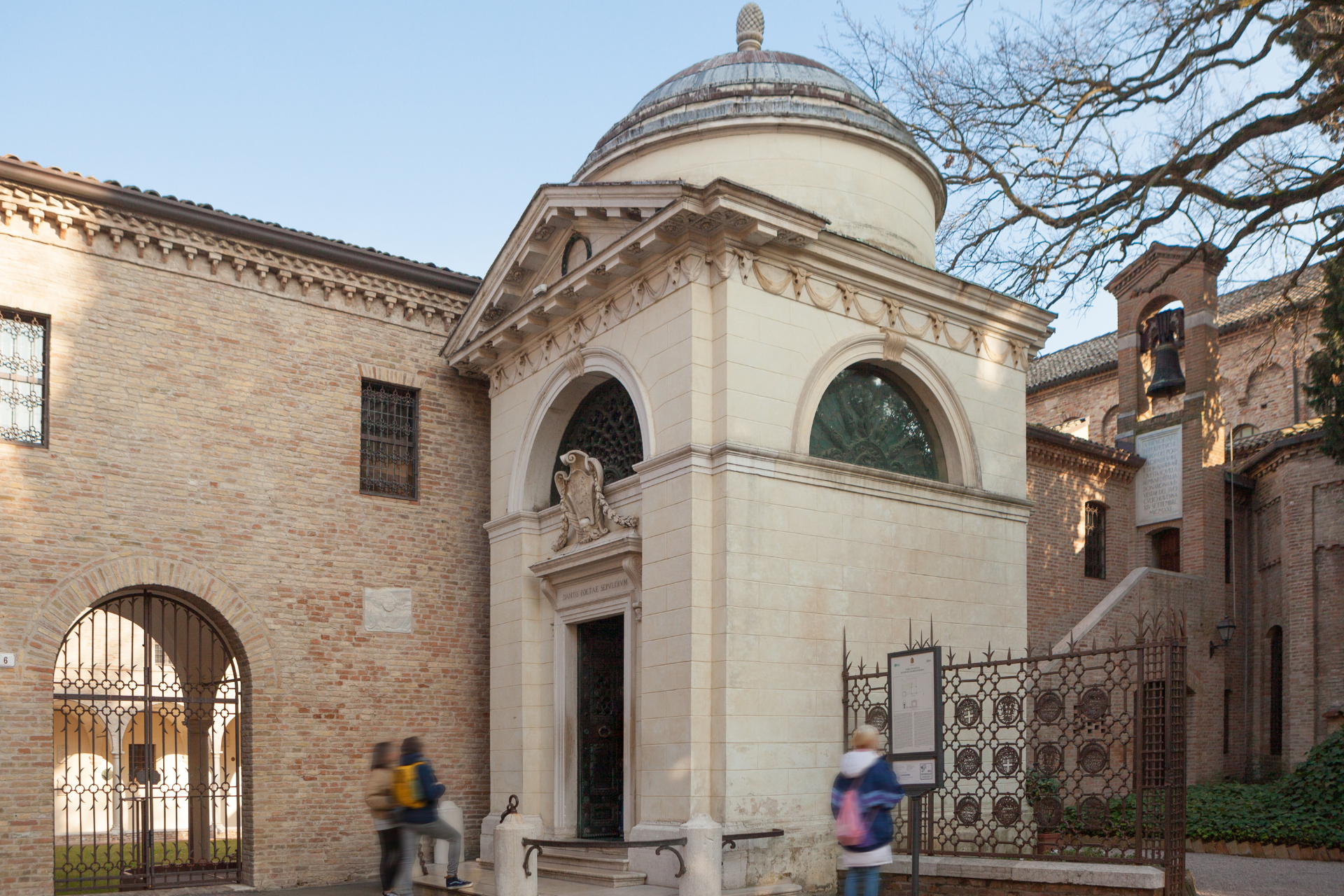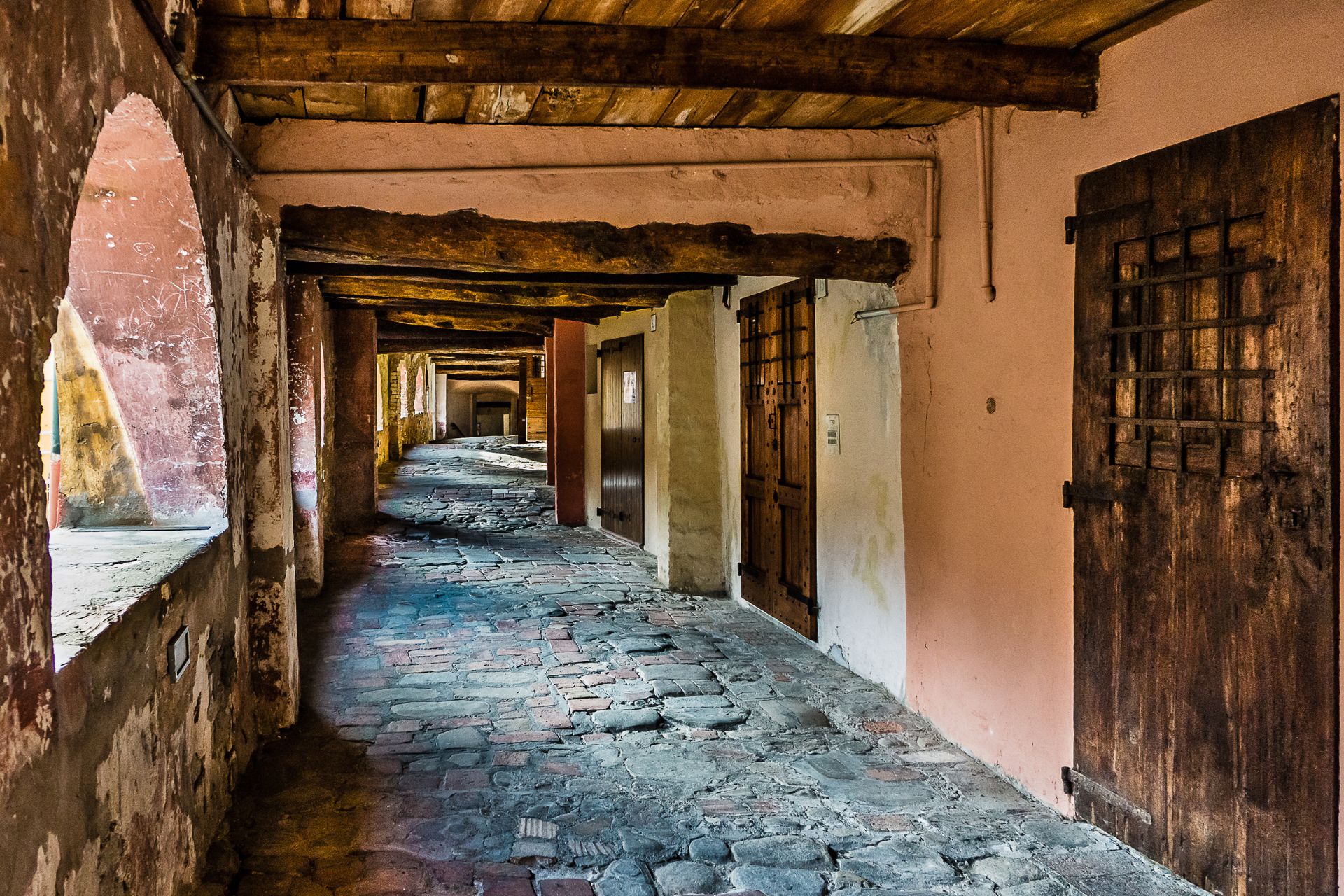Dante Alighieri's tomb is one of the most emblematic and significant places in Ravenna, bearing witness to the Supreme Poet's last resting place. Located near the basilica of San Francesco, in the heart of the city of Ravenna, the neoclassical tomb was erected to honour the memory of Dante, who spent the last years of his life in Ravenna, where he died in 1321.
This monument, recognised as a national monument, is surrounded by the evocative 'Dante zone', an area of respect and silence established to preserve the solemnity of the place. The zone includes not only the poet's tomb, but also the garden with the Quadrarco di Braccioforte, the Franciscan cloisters and the Museum and Dante House complex, which offer a cultural and spiritual itinerary dedicated to the figure of the Poet and his immortal work.
The tomb is not only a tribute to Dante's literary genius, but also a place of reflection for anyone wishing to pay homage to the father of the Italian language.
Dante's first tomb
On his deathbed, Dante Alighieri expressed his wish to be clothed in the Franciscan habit, as a sign of his closeness to the spiritual ideals of the Order. For his burial, he chose the convent of the Friars Minor, who had arrived in Ravenna in 1261. The solemn funeral was held in their church, and the poet was originally laid to rest in the cemetery area adjacent to the convent.
This place is known as Quadrarco of Braccioforte, whose name derives from a tradition that tells of two people who, in that place, invoked the 'strong arm' of the Saviour as a guarantor of a contract, inspired by an image of Christ painted nearby. It was inside a burial cell belonging to the Da Polenta family, patrons and protectors of Dante during his exile, that the sarcophagus containing his remains was placed.
In 1441, with the fall of the Da Polenta family to the Venetian Republic, the burial cell fell into a state of neglect. Forty years later, in 1483, the Venetian podestà Bernardo Bembo, a great admirer of Dante, decided to restore and enlarge the tomb at his own expense. For this work, he turned to the famous sculptor Pietro Lombardo, who worked together with his sons. Above the sarcophagus, Pietro sculpted a bas-relief depicting the pensive poet, portrayed in front of a lectern, an image that conveys the intellectual greatness and creative torment of the Supreme Poet.
Dante's present tomb
In 1778, Cardinal Luigi Valenti Gonzaga, installed in Ravenna as papal legate, commissioned the construction of a new shrine for Dante's tomb. The work was entrusted to the Ravenna architect Camillo Morigia, who designed an elegant temple in neoclassical style, built between 1780 and 1781 over the pre-existing 15th-century structure.
Exterior
The tomb, with a square plan, is crowned by a dome surmounted by a pine cone, a symbol of eternity. Separated from the road by a discrete boundary, the façade is simple and linear. On the entrance door, surmounted by the coat of arms of Cardinal Gonzaga, the inscription reads in Latin: Dantis poetae sepulcrum ('Tomb of the poet Dante'). Decorative elements include the ouroboros, a snake biting its tail, symbolising the eternity of the poet's fame, and the cardinal's coat of arms.
To the right of the monument is a small garden that includes the Quadrarco di Braccioforte. Since 1921, the garden has been enclosed by a wrought-iron gate, the work of the Venetian Umberto Bellotto.
Interior
The interior of the sacellum, covered in precious marble and stucco, houses the Poet's sarcophagus, a work from the Roman era. Above the sarcophagus is an epitaph in Latin, attributed to the Veronese grammarian Rinaldo Cavalchini, celebrating Dante's greatness and his exile:
(LA) "Iura monarchiae superos Phlegetonta lacusque
lustrando cecini voluerunt fata quousque
sed quia pars cessit melioribus hospita castris
actoremque suum petiit felicior astris
hic claudor Dantes patriis extorris ab oris
quem genuit parvi Florentia mater amoris'.(EN)The rights of the monarchy, the skies and waters of Phlegethon
Visiting I sang, as long as my mortal destiny willed.
But since my soul went as a guest to better places
And blest among the stars she reached her Creator,
Here am I, Dante, exiled from my homeland,
to whom spawned Florence, mother of little love'.
Above the sarcophagus is a bas-relief by Pietro Lombardo, depicting Dante pensively before a lectern. At the foot of the sarcophagus, there is a bronze and silver crown donated in 1921 by the Italian Army and Navy for the 6th centenary of the Poet's death. On the right, an alabaster column from the Karst holds a silver ampulla donated in 1908 by Trieste, Trento, Gorizia and other Italian provinces then under Austro-Hungarian rule.
An eighteenth-century votive lamp burns perpetually on the ceiling, fuelled by olive oil from the Tuscan hills, an annual gift from the city of Florence, offered on the second Sunday of September in memory of Dante's death, which occurred on the night of 13-14 September 1321. This tradition was established in 1908.
Restorations and interventions
The tomb has undergone various restorations over the centuries. In 1921, for the 6th centenary of Dante's death, it was restored to a design by superintendent Ambrogio Annoni, with the collaboration of sculptor Lodovico Pogliaghi. During this intervention, the old wooden doors were replaced with bronze doors donated by the Municipality of Rome.
In 2020, in preparation for the 7th centenary of the Poet's death (13 September 2021), the tomb underwent a new restoration. The work involved both the decorative apparatus of the temple, inside and outside, and the area of the Quadrarco di Braccioforte. After the restoration was completed, a Greek cross donated in 1965 by Pope Paul VI was relocated inside the sepulchre. This cross, set with four amethysts, symbolises the resurrection and is positioned above the Lombard's marble slab.
The story of Dante's remains
The day after Dante's death, his body was buried in the sarcophagus that still holds his remains today, initially placed on the back wall of the Polentani cell in the Braccioforte cloister. However, as early as the 14th century, the Florentines began to claim the relics of their illustrious fellow citizen. Official requests to bring the remains back to Florence were made in 1396, 1428 and 1476, but all were unsuccessful.
The attempts to move and the intervention of the Franciscan friars
At the end of the 15th century, the Venetian podestà Bernardo Bembo moved the sarcophagus to the west side of the cloister. With the ascension to the papal throne of the Florentine popes Leo X and Clement VII, both of the Medici family, the Florentines believed they could finally bring the poet's bones back to their city. Leo X granted permission to remove the relics in 1519 and Michelangelo was commissioned to design a funeral monument. However, when the Florentine delegation opened the sarcophagus, the bones had disappeared.
The Franciscan friars, fearing the move, had drilled a hole in the back wall and secretly removed Dante's remains. These were hidden and guarded in great secrecy. In 1677, the prior of the convent, Antonio Sarti, enclosed the bones in a wooden box, which is now preserved in the Dante Museum.
Hiding places and finding bones
In 1810, following the suppression of religious orders by the Napoleonic government, the friars decided to hide the relics again. The box was walled up in the oratory of the Braccioforte cloister. The friars left the city, and all trace of the box was lost. For decades, visitors to the tomb were unaware that the sarcophagus was empty.
The bones were found by chance on 27 May 1865, during restoration work for the 6th centenary of Dante's birth. A bricklayer discovered the box, and a young student, Anastasio Matteucci, interpreted the inscription: Dantis ossa a me fra Antonio Sarti hic posita anno 1677 die 18 octobris. The skeleton was reassembled with silver threads and placed in a crystal urn, displayed to the public for three days, attracting thousands of visitors, mainly from Tuscany. Afterwards, the bones were placed in a walnut box protected by a lead coffin and placed in the small temple designed by Morigia.
Subsequent events and reconnaissance
In 1921, on the occasion of the 6th centenary of the poet's death, a survey of the relics was carried out by anthropologists Giuseppe Sergi and Fabio Frassetto. During World War II, to protect them from bombing, the bones were again hidden, buried a few metres from the mausoleum, under a mound covered by vegetation. They were recovered and relocated in 1945.
Cenotaph in Florence
In Florence, despite the impossibility of obtaining the relics, a neoclassical cenotaph was erected in 1829 in the Basilica of Santa Croce. The work depicts Dante seated, pensive, raised in glory by Italy, while Poetry weeps bending over the sarcophagus, a symbol of love and regret for the exiled Supreme Poet.





